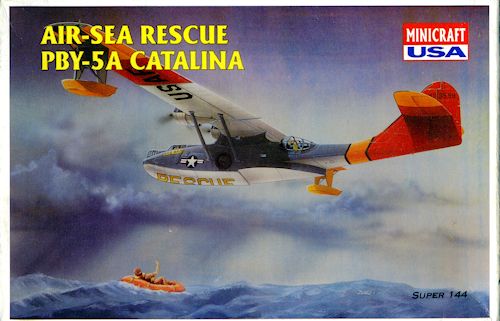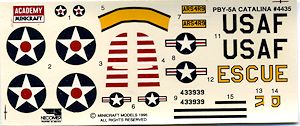
Minicraft 1/144 PBY-5A Catalina
| KIT #: | 4435 |
| PRICE: | $Currently out of production |
| DECALS: | Two options |
| REVIEWER: | Scott Van Aken |
| NOTES: | Air-Sea Rescue boxing |

| HISTORY |
The Consolidated PBY Catalina was an American flying boat, and later an amphibious aircraft of the 1930s and 1940s produced by Consolidated Aircraft. It was one of the most widely used seaplanes of World War II. Catalinas served with every branch of the United States Armed Forces and in the air forces and navies of many other nations.
During World War II, PBYs were used in anti-submarine warfare, patrol bombing, convoy escorts, search and rescue missions (especially air-sea rescue), and cargo transport. The PBY was the most numerous aircraft of its kind and the last active military PBYs were not retired from service until the 1980s. Even today, nearly 80 years after its first flight, the aircraft continues to fly as a waterbomber (or airtanker) in aerial firefighting operations all over the world.
The designation "PBY" was determined in accordance with the U.S. Navy aircraft designation system of 1922; PB representing "Patrol Bomber" and Y being the code assigned to Consolidated Aircraft as its manufacturer. Catalinas built by other manufacturers for the US Navy were designated according to different manufacturer codes, thus Canadian Vickers-built examples were designated PBV, Boeing-Canada examples PB2B (there already being a Boeing PBB) and Naval Aircraft Factory examples were designated PBN. Canadian examples were named Canso by the Royal Canadian Air Force in accordance with contemporary British naming practice of naming seaplanes after coastal port towns, in this case for the town of Canso in Nova Scotia while the Royal Air Force used the name Catalina. The United States Army Air Forces and later the United States Air Force used the designation OA-10. Navy Catalinas used in the Pacific against the Japanese for night operations were painted black overall, and as a result were sometimes referred to locally as "Black Cats". The PBY-5A was the amphibious version and the most widely built with production running from October of 1941 until January 1945.
| THE KIT |
 Minicraft
has concentrated most of its new kit efforts to 1/144 scale and while they have
done quite a few kits, most of them have been lambasted by the experts for shape
errors. Having built a few, I have not issues with them aside from their
requirements for modeling skills and the difficulty of building them gear up.
Minicraft
has concentrated most of its new kit efforts to 1/144 scale and while they have
done quite a few kits, most of them have been lambasted by the experts for shape
errors. Having built a few, I have not issues with them aside from their
requirements for modeling skills and the difficulty of building them gear up.
The Catalina is nicely molded with well done engraved panel lines and parts that are free from flash and sunken areas. As kits go, it is not complex, though it does have some rather finely molded bits which one will need to be careful of when removing them from the sprue. There are not a lot of options, though one of them is the option for three different nose turrets. Since the instructions seem to be for all the different boxings, the one appropriate for this boxing is not indicated, requiring a bit of research. The other option is for gear up, though there is no display stand provided. There are some steps through the build that are for the gear up option so one needs to decide rather early how this will be displayed.
The cockpit has molded in setas and includes the mount for the nose turret. Two control sticks are provided and that is about it. Wheel wells for the main gear are also separate while the nose gear plugs into a hole in the bottom of the cockpit. One can also build the kit with the floats raised, this option only being needed for an in-flight display. Engines are generic but good enough for the scale and fit into one-piece cowlings. Cockpit and side clear bits are fairly nicely done and will require some careful masking as there are a lot of small panes.
Instructions provide generic paint references and are easy to follow. Markings are offered for two planes.
One is a post war box art plane of the USAF. I found a photo of this plane on
the net and noticed that there is a difference between what is shown on the box
art and what is shown in the instructions, primarily regarding the background of
the serial
paint references and are easy to follow. Markings are offered for two planes.
One is a post war box art plane of the USAF. I found a photo of this plane on
the net and noticed that there is a difference between what is shown on the box
art and what is shown in the instructions, primarily regarding the background of
the serial  number.
ASV radar will also need to be added. This plane will have been unarmed. This is
by far the most colorful scheme. The other is a pre-war PBY-5A in generic
markings with no unit codes. I'm thinking that some research will turn up
something appropriate. Decals seem to be well done, though in my kit, which was
a raffle wing, they have curled and may not be viable, especially considering
they are printed in Mexico and I've had issues with previous Mexico printed
decals that are not new.
number.
ASV radar will also need to be added. This plane will have been unarmed. This is
by far the most colorful scheme. The other is a pre-war PBY-5A in generic
markings with no unit codes. I'm thinking that some research will turn up
something appropriate. Decals seem to be well done, though in my kit, which was
a raffle wing, they have curled and may not be viable, especially considering
they are printed in Mexico and I've had issues with previous Mexico printed
decals that are not new.
| CONCLUSIONS |
Overall, this looks like a very nice kit. I'm sure there is something amiss with it that most of us would never notice, and it should make into a nice model for those who are fans of the scale.
| REFERENCES |
http://en.wikipedia.org/wiki/Pby_catalina
2014 Thanks to the luck of the draw for this one. If you would like your product reviewed fairly and fairly quickly, please contact the editor or see other details in the
Note to
Contributors.